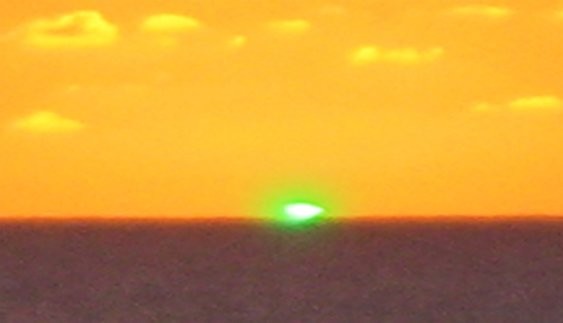
THE GREEN FLASH
The green flash is a rare optical phenomenon that occurs shortly after sunset, or before sunrise, when a green spot is visible for an instant just above the sun. It is usually seen on an unobstructed horizon, such as over the ocean or a lake.
Remember, even when the sun is setting, it is dangerous to look directly at the sun. While waiting to see the green flash at sunset, look away until only the very top of the sun is about to disappear below the horizon. It is only during this last instant that the green flash will be visible. The green flash is seen only when it is absolutely clear all the way to the horizon – so don’t expect to see it every night or every morning!
Why does the green flash happen? The basic cause of the colour is atmospheric dispersion. Light travels in straight lines in empty space but not when light interacts with matter. Refraction is what happens when you put a pencil in a glass of water at an angle. When you look at the pencil, it appears to be bent at the surface. This is the same for light in the atmosphere. The refraction of light by the air is larger for shorter wavelengths. At sunset the refractive delay of the sunset is usually a second or two longer for blue and violet than for red. So the red image of the sun sets first, followed by the yellow, the green, the blue and finally the violet.
So why don’t we have a violet flash? It is because of atmospheric extinction. Air molecules and dust scatter the short wavelengths most strongly. This is why the sky is blue. The scattered blue light goes in all directions so we see it everywhere. At the horizon, the length of the path through the air is very long and the shortest wavelengths are almost completely removed. Usually there is just enough haze in the air that both violet and blue are completely removed, so that the last thing we see at sunset or the first thing we see in the morning is the green.
So watch the sunset, or the sunrise if you’re an early bird, with your friends – but be patient.
Dr. Young has over 40 years of experience in weather and air quality studies and continues to provide services in these areas at RWDI. He welcomes feedback on his blogs as well as requests and suggestions for future topics. He can be reached at Jim.Young@rwdi.com